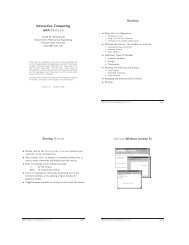"O Soul, Come Back!" A Study in The Changing Conceptions of The ...
"O Soul, Come Back!" A Study in The Changing Conceptions of The ...
"O Soul, Come Back!" A Study in The Changing Conceptions of The ...
You also want an ePaper? Increase the reach of your titles
YUMPU automatically turns print PDFs into web optimized ePapers that Google loves.
SOUL AND AFTERLIFE 377and the p 'o governs his body (<strong>in</strong>clud<strong>in</strong>g the senses.) It is <strong>in</strong>terest<strong>in</strong>gto po<strong>in</strong>t out that a similar dist<strong>in</strong>ction between the hun and the p'ocan also be found <strong>in</strong> Han Taoist literature. Accord<strong>in</strong>g to the HoshangCommentary on the Lao Tzu, heaven feeds man with five k<strong>in</strong>ds <strong>of</strong>ch'i, which enter his body from the nostrils and are stored <strong>in</strong> hisheart (or m<strong>in</strong>d). <strong>The</strong> five k<strong>in</strong>ds <strong>of</strong> ch'i are pure and subtle andtherefore go to form man's spirit, senses, voice etc. Thus a man hasa soul called hun. <strong>The</strong> hun is mascul<strong>in</strong>e; it goes out and comes <strong>in</strong>through the nostrils and communicates with heaven. Earth feedsman with five tastes which enter his body from the mouth and arestored <strong>in</strong> the stomach. <strong>The</strong> five tastes are impure and therefore go t<strong>of</strong>orm a man's body, bones and flesh, blood and ve<strong>in</strong>s, as well as sixemotions. Thus a man has a soul called p 'o. <strong>The</strong> p 'o is fem<strong>in</strong><strong>in</strong>e; itgoes out and comes <strong>in</strong> through the mouth and communicates withearth.3' Although there are differences between the Confucian andthe Taoist versions with regard to the respective functions <strong>of</strong> the hunearthly ch'i while his m<strong>in</strong>d or heart is the seat <strong>of</strong> the ref<strong>in</strong>ed, heavenly ch'i (see D. C. Lau's"Introduction" <strong>in</strong> Mencius, p. 24). Although Mencius did not mention the ideas <strong>of</strong> hun andp'o <strong>in</strong> his philosophical discussions, it is nevertheless unmistakable that his dist<strong>in</strong>ction betweenthe ta-t 'i and the hsiao-t 'i bears a resemblance to the dist<strong>in</strong>ction between the hun and p 'oas def<strong>in</strong>ed by Cheng Hsuian, not only structurally but also functionally. In view <strong>of</strong> the gradualfusion <strong>of</strong> the ideas <strong>of</strong> hun and p'o s<strong>in</strong>ce the sixth cetury B.C., I f<strong>in</strong>d it difficult to resist the temptationto l<strong>in</strong>k this Mencian formulation to a contemporary dualistic conception <strong>of</strong> the soul as apossible model. If so, then Cheng Hsiuan's <strong>in</strong>terpretation <strong>of</strong> the different functions <strong>of</strong> the hunand the p'o may well have been <strong>of</strong> a much earlier (i.e. pre-Han) orig<strong>in</strong>. Traditionally, it hasbeen contended, especially by the Ch'<strong>in</strong>g philologists, that the commentaries written by HanConfucian exegetes may, by and large, be viewed as depositories <strong>of</strong> ideas <strong>of</strong> classical antiquitytransmitted orally from generation to generation down to Han times. It seems likely thatCheng Hsuian's ideas about hun and p'O have precisely such ancient orig<strong>in</strong>s.3' Lao Tzu tao-te ch<strong>in</strong>g TAftg. (SPTK edition), A.3b. Here the hun-ch'i is clearly describedas a breath-like life force. In this respect, the Ch<strong>in</strong>ese idea <strong>of</strong> hun is certa<strong>in</strong>ly comparableto its counterparts <strong>in</strong> other ancient cultures. <strong>The</strong> Greek psyche and thymos, the Romananimus and anima, and the Jewish nephesh, for <strong>in</strong>stance, were all associated with breath. SeeRichard Broxton Onians, <strong>The</strong> Orig<strong>in</strong>s <strong>of</strong> European Thought About the Body, the M<strong>in</strong>d, the <strong>Soul</strong>, theWorld, Time, and Fate, (Cambridge: Cambridge University Press, 1954), esp. pp. 44-46 and66-69 (for thymos); 93-95 (for psyche); 168-73 (for anima and animus); 481-82 (for nephesh).Onians is basically right <strong>in</strong> po<strong>in</strong>t<strong>in</strong>g out the similarity between the Ch<strong>in</strong>ese idea <strong>of</strong> hun-ch'iand the Greek and Roman ideas <strong>of</strong> soul, even though his discussions <strong>of</strong> "Ch<strong>in</strong>ese conception<strong>of</strong> the soul" (pp. 520-30) are full <strong>of</strong> factual errors as well as anachronisms. For psyche assometh<strong>in</strong>g airy and breath-like, see the classic study <strong>of</strong> Erw<strong>in</strong> Rohde, Psyche, tr. by W. B.Hillis, (New York: 1925), pp. 4-5; also Emily Vermeule, Aspects <strong>of</strong> Death <strong>in</strong> Early Greek Art andPoetry, (Berkeley: University <strong>of</strong> California Press, 1979), pp. 212-13 (note 11 to chapter one);and Bruno Snell, <strong>The</strong> Discovery <strong>of</strong> the M<strong>in</strong>d, <strong>The</strong> Greek Orig<strong>in</strong>s <strong>of</strong> European Thought, tr. by T. G.Rosenmeyer (Cambridge, Mass: Harvard University Press, 1953), pp. 8-12 (for a discussion<strong>of</strong> psyche and thymos).















